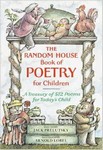Through the Looking Glass Children's Book Reviews
The Random House Book of Poetry for Children
Illustrator: Arnold Lobel
Poetry Book
For ages 6 to 9
Random House, 1983
Some people call anthologies treasuries, which is an excellent name to use for books that are full of written treasures. This book is indeed a treasury, packed with no less than five hundred and seventy-two poetry treasures, each one of which is unique and special. The poems are categorized into fourteen sections, so that children can find poems that suit their mood. These categories include “The Four Seasons,” “The Ways of Living Things,” “Nonsense! Nonsense!” and “Where Goblins Dwell.”
Each section is introduced by a poem written by Jack Prelutsky, a poet who is also the person who selected the poems that are included in this collection. Jack Prelutsky has visited schools and libraries for years and he has noticed that though little children have a natural affinity for poetry and love their nursery rhymes, older children seem to “find poetry boring and irrelevant.”
Jack Prelutsky has worked hard to figure out which kinds of poems appeal to this more critical audience, and he has determined that poems that amuse or surprise, those that “paint pictures” and that “reawaken pleasure in the sounds and meanings of language,” are the ones that these children tend to like. Armed with this knowledge, Jack Prelutsky set about putting together this collection, which he feels best suits elementary school children. He focused on poems that are relevant today, which means that long narrative or “inspirational” poems that appealed to audiences in the past were not included.
The collection begins with poems about nature, and here we find poems of all kinds that capture the beauty found in nature. Some of them are gently humorous, while others have a more serious, contemplative feel. There are poems about plants and trees, the wind, rivers and the sea, snow and rain, and those that look at the night, the moon and the stars. The transition from subject to subject is smooth and has a flow all of its own.
In “The Four Seasons” we journey through the year looking at the months, holidays, and the weather as the year unfolds. We experience the joys of each season, and appreciate that each one has something special to offer.
Furry animals come next in “Dogs and cats and bears and bats.” Here we meet creatures great and small. Bears, mice, foxes, elephants, seals, and pigs all appear on these pages, and children will encounter story poems, descriptive poems and so much more. Insects, fish, reptiles, amphibians, and birds follow in “The ways of living things.”
The poets whose creations appear on these pages are both modern poets and poets whose work was written many years ago. For example, Lewis Carroll’s poetry rubs shoulders with verse written by Bobbi Katz. Many familiar names appear, names such as Roald Dahl, Edward Lear, Shel Silverstein, Jane Yolen and Russell Hoban, among others.
On every page, illustrations break up the columns of text to give the eye something new to look at, and the pictures beautiful complement the poems.



